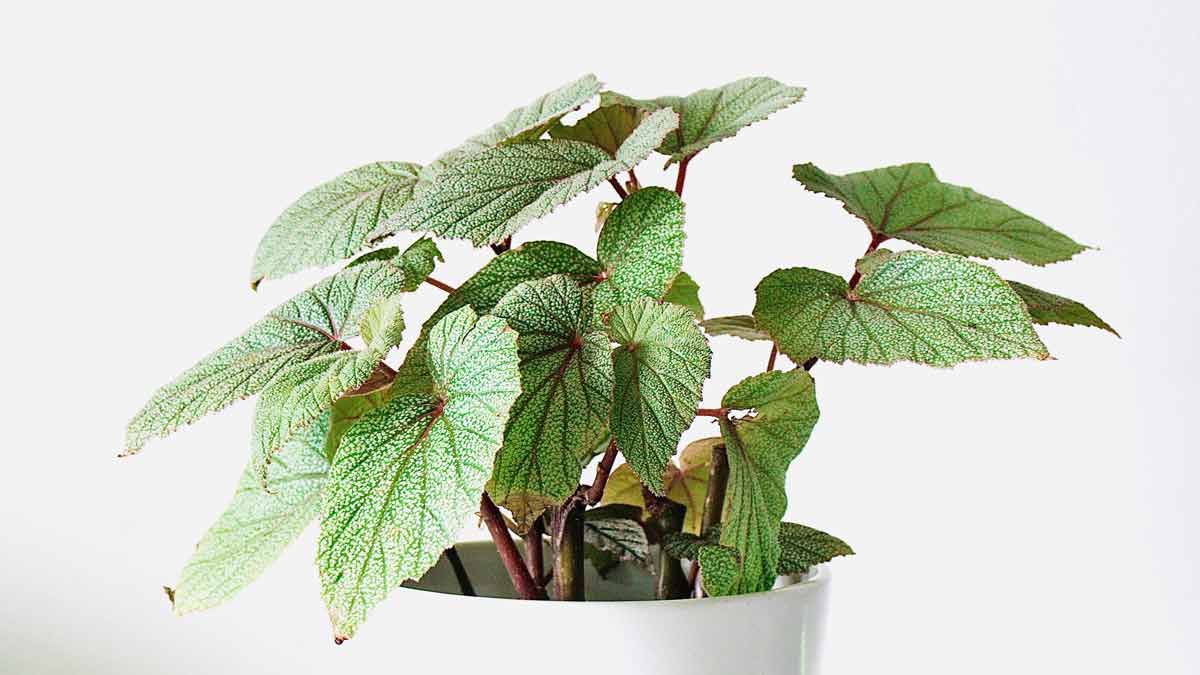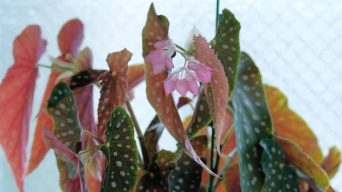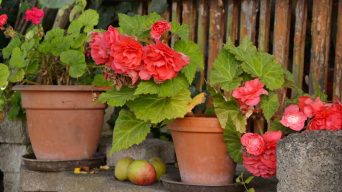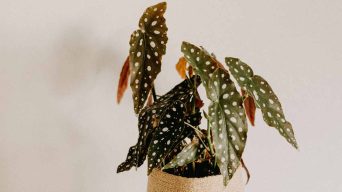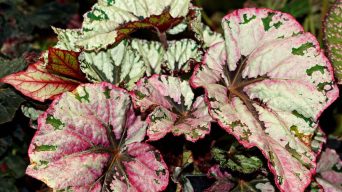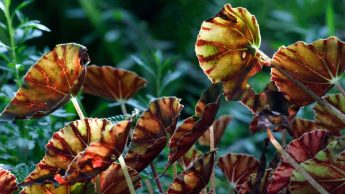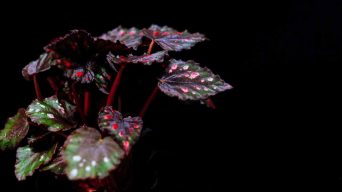Brown Begonia leaves may result from underwatering or overexposure to direct sunlight. Other possible causes are low humidity, poor nutrition, pests, and diseases. Proper care, including watering, light, humidity, and nutrients, is crucial for preventing brown leaves and maintaining plant health.
Begonias are cherished houseplants known for their stunning foliage and bright blooms.
However, it can be alarming when the vibrant green leaves take on a brown hue.
Here, we’ll explore common causes of Begonia leaves turning brown and provide practical solutions to restore your plant’s health.
So whether you’re new to Begonias or an experienced grower looking for answers, let’s dive in together to help your plants thrive!
Causes Of Begonia Leaves Turning Brown
Begonia plants are beautiful and popular houseplants known for their vibrant foliage.
However, the leaves can turn brown due to various reasons, including improper watering, direct sunlight exposure, low humidity, nutrient deficiencies, pest infestations, and fungal diseases.
Identifying the root cause of the browning leaves is crucial in determining the appropriate treatment to restore the plant’s health and beauty.
Improper Watering
Improper watering is a common cause of Begonia leaves turning brown.
Underwatering and overwatering can lead to this issue, as the plant’s roots struggle to deliver adequate nutrients and moisture to the foliage.
In particular, Begonias prefers consistently moist soil that is not soggy or waterlogged.
An improper balance could leave you with wilted or discolored leaves.
For instance, if a gardener doesn’t provide enough water for their Polka Dot Begonia, its leaves may develop brown tips or edges as they dry out.
Conversely, overwatering can cause rotting roots, depriving the plant of essential oxygen and leading to yellowing leaves and browning.
Exposure To Direct Sunlight
Exposure to direct sunlight is one of the primary reasons Begonia leaves turn brown.
Begonias are not sun-loving plants, including varieties like Begonia maculata, Angel Wing Begonia, Polka Dot Begonia, and Rex Begonia.
They thrive in bright, indirect light rather than harsh sunlight.
Direct sunlight can cause the delicate foliage of your beloved begonia plant to become scorched or burned.
This damage manifests as browning leaf edges or even entire leaves appearing crisp and discolored.
The spotted patterns on some types of begonias, such as the Dot and Polka Dot varieties, may fade with prolonged exposure to direct sunlight – further compromising their aesthetic appeal.
Low Humidity
Low humidity is a common cause of Begonia leaves turning brown, particularly for species like the Rex Begonia and Polka Dot Begonia, which thrive in higher humidity environments.
Indoor plants often suffer from this problem since many homes have low humidity levels due to heating and air conditioning systems.
When the environment around your beloved Begonias lacks sufficient moisture, the plant’s cells can lose water faster than they can replace it.
As a result, leaf tips and edges become crisp and turn brown.
Nutrient Deficiencies
Nutrient deficiencies can also cause Begonia leaves to turn brown.
This means your plant is not getting enough of the essential minerals needed for healthy growth.
Common examples include a lack of nitrogen or iron in the soil.
Nutrient deficiencies can lead to stunted growth and weakened plant health if left untreated.
Pest Infestations
Pests like spider mites, mealybugs, and thrips can significantly threaten your beloved begonia plants.
These insects can cause discoloration, wilting, and deformation of leaves. They also expose the plant to secondary infections that can lead to stunted growth or death.
Overwatering and poor soil drainage create favorable conditions for pest infestation in Begonias.
Fungal Diseases
Fungal diseases can often be a culprit when Begonia leaves turn brown.
Botrytis blight, powdery mildew, and bacterial leaf spot are all common fungal infections that can cause discoloration on the leaves of your begonia plant.
These fungi thrive in warm and humid conditions, making it important to keep your plants dry by properly watering them and providing good air circulation.
Different types of fungal infections display different symptoms on the leaves.
Powdery mildew displays as white or gray patches on the upper portion of the leaf.
At the same time, botrytis blight may show up as water-soaked spots which eventually turn brown with time.
Bacterial leaf spot appears as small water-soaked areas that enlarge into spots with yellow halos.
Solutions For Begonia Leaves Turning Brown
Learn how to prevent and solve the issue of brown Begonia leaves with these simple solutions.
Proper watering, shading, humidity levels, fertilization, pest control, and disease treatment are all essential to caring for your precious Begonia plants.
Proper Watering Techniques
Using proper watering techniques is crucial to prevent Begonia leaves from turning brown.
Here are some tips for watering your Begonia plants:
- Water your Begonias when the top inch of the soil feels dry.
- Use room temperature water and avoid using cold water straight from the tap.
- Water your plant thoroughly until water drains out of the bottom of the pot, ensuring that all roots receive moisture.
- Avoid overwatering, which can lead to root rot, and brown Begonia leaves.
- Don’t allow your Begonia plant to sit in standing water, which can also cause root rot and brown leaves.
- Adjust your watering schedule according to seasonal changes in temperature and humidity levels.
Providing Adequate Shade
Begonias are incredibly versatile and adaptable plants that can thrive in various conditions.
However, too much direct sunlight can damage the plant, causing its leaves to turn brown.
Providing adequate shade is an effective solution to this problem.
Consider moving your Begonia away from windows or other sources of direct sunlight and placing it in an area with bright but indirect light instead.
Another way to provide shade is by using sheer curtains or blinds during the hottest parts of the day.
This will help protect your Begonia from harsh sun rays and reduce water loss due to evaporation caused by high temperatures.
Keep in mind that different types of Begonia may have slightly different requirements when it comes to light exposure, so it’s always best to do some research before making any changes.
Ensuring proper shading will help maintain healthy Begonia foliage without turning brown or yellow while promoting growth throughout the year.
Adjusting Humidity Levels
Maintaining the proper humidity levels prevents begonia leaves from turning brown.
Begonia plants require high humidity levels, which can be challenging in dry environments or during winter when indoor heating systems take over.
Place pebble trays filled with water near your plant to increase humidity, mist the leaves regularly, or use a humidifier.
Another helpful tip is to group several plants as they release moisture through transpiration, increasing the overall humidity of their surroundings.
On the other hand, if your Begonia’s environment is too damp and stagnant air circulates around it- it can lead to fungal growth that causes brown spots on its foliage.
Therefore, proper ventilation also plays an essential role in maintaining optimal humidity levels for your plant to thrive.
A well-ventilated room ensures that excess moisture evaporates quickly and prevents mold formation on leaves.
Adjusting your Begonia’s surrounding conditions and paying attention to its changing needs throughout different seasons will help maintain healthy foliage and prevent brown leaves caused by low or excessive humidity levels.
Fertilizing Properly
Proper fertilization is critical to ensuring your Begonia plants remain healthy and vibrant.
When it comes to fertilizer, less is often more!
Too much of the wrong fertilizer type can harm your plant rather than help it.
Stick with a balanced, water-soluble fertilizer that contains equal parts nitrogen, phosphorus, and potassium – this will provide all the nutrients your Begonia needs without overdoing it.
Additionally, fertilize only during the growing season when your plant produces new growth.
It’s important not to overlook the role of soil quality in proper fertilization.
Your potting mix should be loose and well-aerated; compacted soil prevents vital oxygen from reaching roots and can lead to root rot.
Consider adding organic matter like compost or worm castings to improve soil fertility- these materials will also help with moisture retention.
Pest Control
Pests can be a major problem for Begonia plants, and cause leaves to turn brown.
Here are some effective ways to control pests:
- Use insecticidal soap: You can use insecticidal soap to control soft-bodied pests like spider mites, mealybugs, and aphids. Apply the soap solution directly to the infected leaves.
- Neem oil: Neem oil is a natural pesticide that can control various pests, including whiteflies, thrips, and scale insects. Mix neem oil with water and spray it onto the affected leaves.
- Sticky traps: Sticky traps are an effective way to catch flying insects like fungus gnats and whiteflies. Place sticky traps close to your Begonia plant to trap the flying pests.
- Pruning: Remove infected leaves or stems immediately, as they can attract more pests and spread diseases.
- Preventative measures: Keep your Begonia plant healthy by providing proper care, including adequate watering, fertilization, and lighting conditions. A healthy plant is less likely to be attacked by pests.
By controlling pest infestations through these methods, you can prevent further damage to your Begonia plant’s leaves from turning yellow or brown caused by these pesky intruders.
Treating Diseases
If your begonia leaves are turning brown due to diseases, taking action quickly is essential.
Here are some tips for treating diseases that may be causing the problem:
- Bacterial Leaf Spot: Remove all infected leaves and dispose of them properly. Avoid overhead watering and keep the leaves as dry as possible.
- Powdery Mildew: Increase ventilation and decrease humidity levels around the plant. Prune affected areas and remove all infected debris in the surrounding soil.
- Botrytis Blight: Remove all infected plant material immediately, including leaves, stems, and flowers. Avoid overhead watering and ensure proper air circulation.
- Fungus: Several types of fungus can infect begonias, including stem rot and leaf blight. Treatment varies depending on the specific type of fungus, but removing all infected foliage is a good start.
Remember that prevention is critical when it comes to plant diseases.
Proper care for your Begonia plant will help prevent future infections from occurring.
Final Thoughts
Brown leaves on your Begonia can be unsightly and concerning for any plant enthusiast.
Fortunately, you can easily prevent or treat this issue with the right knowledge and care.
Adjust watering techniques, provide adequate shade and humidity levels, fertilize appropriately, control pests and diseases as needed, and prune affected leaves promptly.
By taking these steps and acting quickly when necessary, you can ensure your Begonia plants stay healthy and vibrant year-round.
So don’t let brown leaves get you down – take action today to keep your beloved Begonias looking their best!

